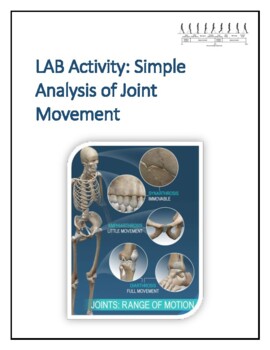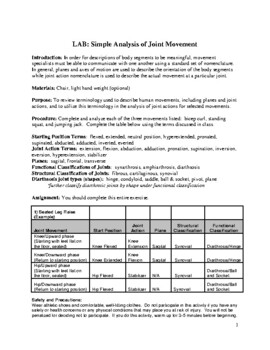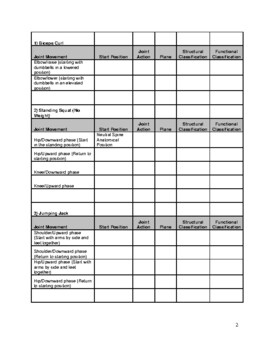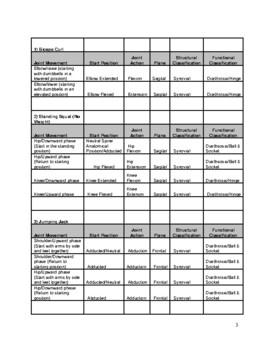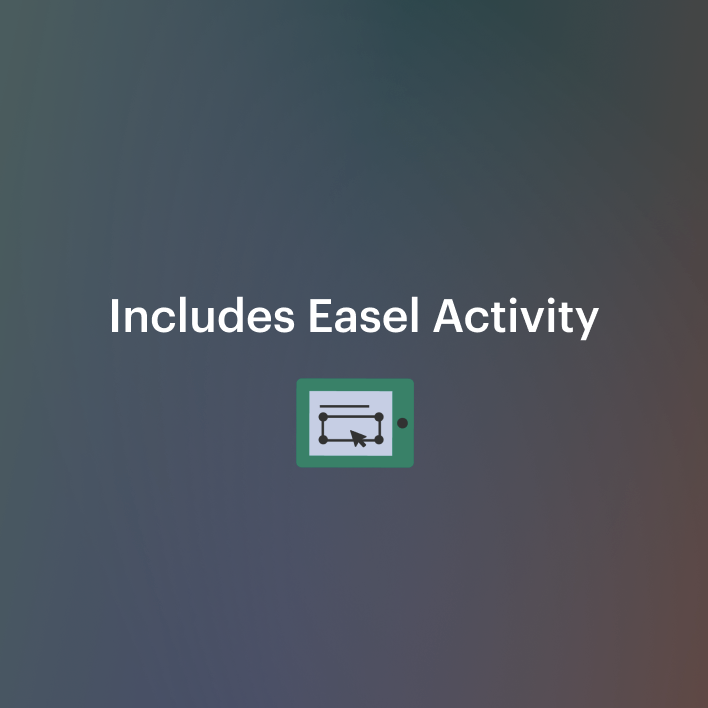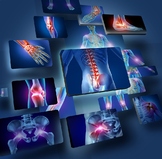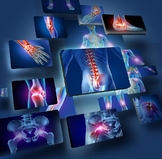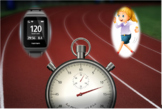Anatomy & Physiology Lab Activity: Analysis of Joint Movement (Virtual Friendly)
- PDF
- Easel Activity
What educators are saying
Also included in
- This bundle contains three of my most popular items. My students love doing the lab activities in this unit. The lab quiz is especially effective at assessing how well students mastered the learning objectives. Enjoy!The Lab:In this fun, engaging lab student will: Complete and analyze each of thePrice $7.99Original Price $11.97Save $3.98
- The Unit PlanMake teaching Anatomy & Physiology easy with this combined unit and daily lesson plan that covers 12 blocks or 22 periods of a secondary A & P course. SIOP, gifted, and differentiation strategies are embedded and easily identified throughout. Lessons are differentiated accordiPrice $15.99Original Price $28.25Save $12.26
- Make teaching Anatomy & Physiology super easy with this highly requested anatomy course growing bundle! SIOP, gifted, and differentiation strategies are embedded and easily identified throughout each unit plan. Lessons are differentiated according to learning style, grouping, and language abilPrice $332.80Original Price $446.97Save $114.17
- This middle grades science lab and activity set contains 27 of my most popular easy to implement labs and activities for life science, physical science, and forensic science. This bundle will continue to grow to include environmental science and earth/space science activities (Coming soon!).Also avPrice $68.79Original Price $110.75Save $41.96
- Keep your students learning with fun, engaging activities! Browse this amazing collection of simple, yet real world activities, worksheets, and labs. These are some of my favorite end of year activities. You are sure to find something in this bundle your students will love as the keep learning!AlPrice $63.99Original Price $94.93Save $30.94
Description
Make teaching easier with the Human Anatomy & Physiology Unit 5 Lab Activity: Analysis of Joint Movement w/Answer Key! In this unique lab activity, students will review planes and axes of motion used to describe the orientation of body segments and apply what they have learned to accurately describe joint actions. Using common biomechanics nomenclature students will be introduced to methods used to describe everyday movements at a major joints. This activity provides complete background information so students can complete this exercise minimal guidance. This activity is designed to make your job easier!
For other great resources to make teaching easier follow me for updates! If you like my product, don't forget to write a review! Thank you!
Materials: Student worksheet for each student and Teacher Answer Key
Objective: In this fun, engaging lab student will complete and analyze each of the three movements listed: bicep curl, standing squat, and jumping jack using the terms below:
- Starting Position Terms: flexed, extended, neutral position, hyperextended, pronated, supinated, abducted, adducted, inverted, everted
- Joint Action Terms: extension, flexion, abduction, adduction, pronation, supination, inversion, eversion, hyperextension, stabilizer
- Planes: sagittal, frontal, transverse
- Functional Classifications of Joints: synarthrosis, amphiarthrosis, diarthrosis
- Structural Classification of Joints: fibrous, cartilaginous, synovial
- Diarthrosis joint types (shapes): hinge, condyloid, saddle, ball & socket, pivot, plane and further classify diarthrotic joints by shape under functional classification
This lab accompanies my Human Anatomy & Physiology Unit Plan 5: The Skeletal System and my Quiz: Analysis of Joint Movement designed specifically for this lab!
Use this activity alone or get the entire Human Anatomy & Physiology Unit 5: The Skeletal System Growing Bundle! This bundle will includes:
- Human Anatomy & Physiology Unit Plan 5: The Skeletal System
- Unit 5 PowerPoint: The Skeletal System
- Worksheet: Overview of the Skeleton
- Activity: Classification of Bones
- Lab Activity: Postural Assessment of Spinal Curvatures
- Lab Activity: Analysis of Joint Movement
- Lab Activity: Analysis of Joint Movement Quiz
- Case Study: Clinical Case Study: Osteoporosis
- Unit 5 Review Quiz: The Skeletal System
- Unit 5 Test: The Skeletal System
The Unit Plan
Make teaching Anatomy & Physiology easy with this combined unit and daily lesson plan that covers 12 blocks or 22 periods of a secondary A & P course. SIOP, gifted, and differentiation strategies are embedded and easily identified throughout. Lessons are differentiated according to learning style, grouping, and language ability. Both content and literacy standards as well as key vocabulary words, essential questions, activating strategies, instructional strategies, and summarizing strategies are included and highlighted. Video links are provided! (Please note that video links are active but may requires access to United Streaming and/or that you be logged into your google account)
Upon completion of this unit, students will be able to:
Content Standards:
SAP2: Students will analyze the interdependence of the integumentary, skeletal, and muscular systems as these relate the protection, support and movement of the human body.
- Explain how the skeletal structures provide support and protection for tissues, and function together with the muscular system to make movements possible.
SCSh2. Students will use standard safety practices for all classroom laboratory investigations and activities.
- Follow correct procedures for use of scientific apparatus and demonstrate appropriate technique in all laboratory situations.
- Follow correct protocol for identifying and reporting safety problems and violations.
Literacy Standards:
- L11-12RST2: Determine the central ideas of conclusions of a text; summarize complex concepts, processes, or information presented in a text by paragraphing them in simpler but still accurate terms.
- L11-12RST3: Follow precisely a complex multistep procedure when carrying out experiments…
Content Objectives (TSWBAT):
- Distinguish between the axial and appendicular skeletons.
- Discuss the major functions of the skeletal system and bone in particular.
- Classify bones according to shape (4).
- Identify the major anatomical areas of a long bone.
- Describe the microscopic structure of long bone.
- Explain the role of bone salts and organic matrix in making bone both hard and flexible.
- Describe the process of bone formation in the fetus and summarize the vents of bone remodeling throughout life.
- Distinguish between types of bone fractures.
- Identify and name the bones of the skull and the four major skull sutures.
- Describe how the skull of a newborn infant or fetus differs from that of an adult and explain the function of fontanels.
- Describe the structure of cervical, thoracic, and lumbar vertebrae and differentiate between them.
- Discuss the function of intervertebral discs and spinal curvatures (scoliosis, lordosis, and kyphosis).
- Name the components of the thoracic cage and differentiate between true and false ribs.
- Identify the bones of the appendicular skeleton.
- Describe the differences between a male and female pelvis.
- Classify joints according to structure and function.
- Identify risk factors, treatments, and preventive measures of common bone disorders.
- Describe major changes in skeletal development at fetal, infant, youth, and adult stages of life.
- Identify some of the cause of bone and joint problems throughout life.
Language Objectives:
- Discuss the role of the skeleton in protecting the body and maintaining homeostasis.
- Read documented case studies and solve clinical application scenarios related to skeletal diseases and conditions.
- Write, discuss, and use key vocabulary appropriately.
Key Vocabulary: axial skeleton, appendicular skeleton, compact bone, spongy bone, long bones, short bones, flat bones, irregular bones, diaphysis, epiphyses, articular cartilage, epiphyseal line, periosteum, epiphyseal plate, medullary cavity, red marrow, yellow marrow, osteocytes, lacunae, lamellae, Haversian canals, osteon, Haversian system, canaliculi, ossification, osteoblasts, osteoclasts, bone remodeling, hematoma, rickets, fractures, fibrocartilage callus, skull, cranium, frontal bone, parietal bones, temporal bones sagittal suture, coronal suture, occipital bone, ethmoid bone, maxillae, zygomatic bones, lacrimal bones, nasal conchae, mandible, hyoid bone, vertebral column, spine, vertebrae, intervertebral column, herniated disc, scoliosis, kyphosis, lordosis, cervical, thoracic, atlas, axis, transverse process, spinous process, sacrum, bony thorax, thoracic cage, sternum, manubrium, xiphoid process, sternal angle, ribs, true ribs, floating ribs, false ribs, pectoral girdle, clavicle, scapulae, glenoid cavity, acromion, coracoid process, acromioclavicular joint, suprascapular notch, humerus, greater tubercle, lesser tubercle, deltoid tuberosity, radial groove, trochlea, capitulum, coronoid fossa, medial epicondyle, lateral epicondyle, radius, radioulnar joint, styloid process, olecranon, trochlear notch, carpal bones, metacarpals, phalanges, pelvic girdle, coxal bones, hip bones, ilium, sacroiliac joint, iliac crest, anterior superior iliac spine, ischium, pubis, obturator foramen, pubic symphysis, acetabulum, false pelvis, true pelvis, outlet, inlet, greater trochanter, lesser trochanter, femur, medial condyle, lateral condyle, patella, tibial tuberosity, medial malleolus, fibula, tarsus, calcaneus, phalanges, metatarsals, joints, articulations, synarthroses, amphiarthroses, diarthroses, fibrous joints, cartilaginous joints, synovial joints, synovial membrane, bursae, tendon sheath, dislocation, plane joint, hinge joint, pivot joint, condylar joint, saddle joint, ball and socket joint, bursitis, sprain, strain, rheumatoid arthritis, osteoarthritis, bone spurs, gout, pannus, ankyloses, fontanels, osteoporosis
I would love to hear from you! I am in the process of uploading related resources. If there is anything you would like to see prioritized, please let me know! If you like my product, don't forget to write a review!
Than you for shopping Best for Teachers!
Check out my EXERCISE AND NUTRITION PLANS FOR TEACHERS ON TPT OR VISIT MY WEBSITE AT REVERSAGE HEALTH & FITNESS! Download my free 1 Week sample Vegetarian Meal Plan for a summer jumpstart weight loss cleanse!

